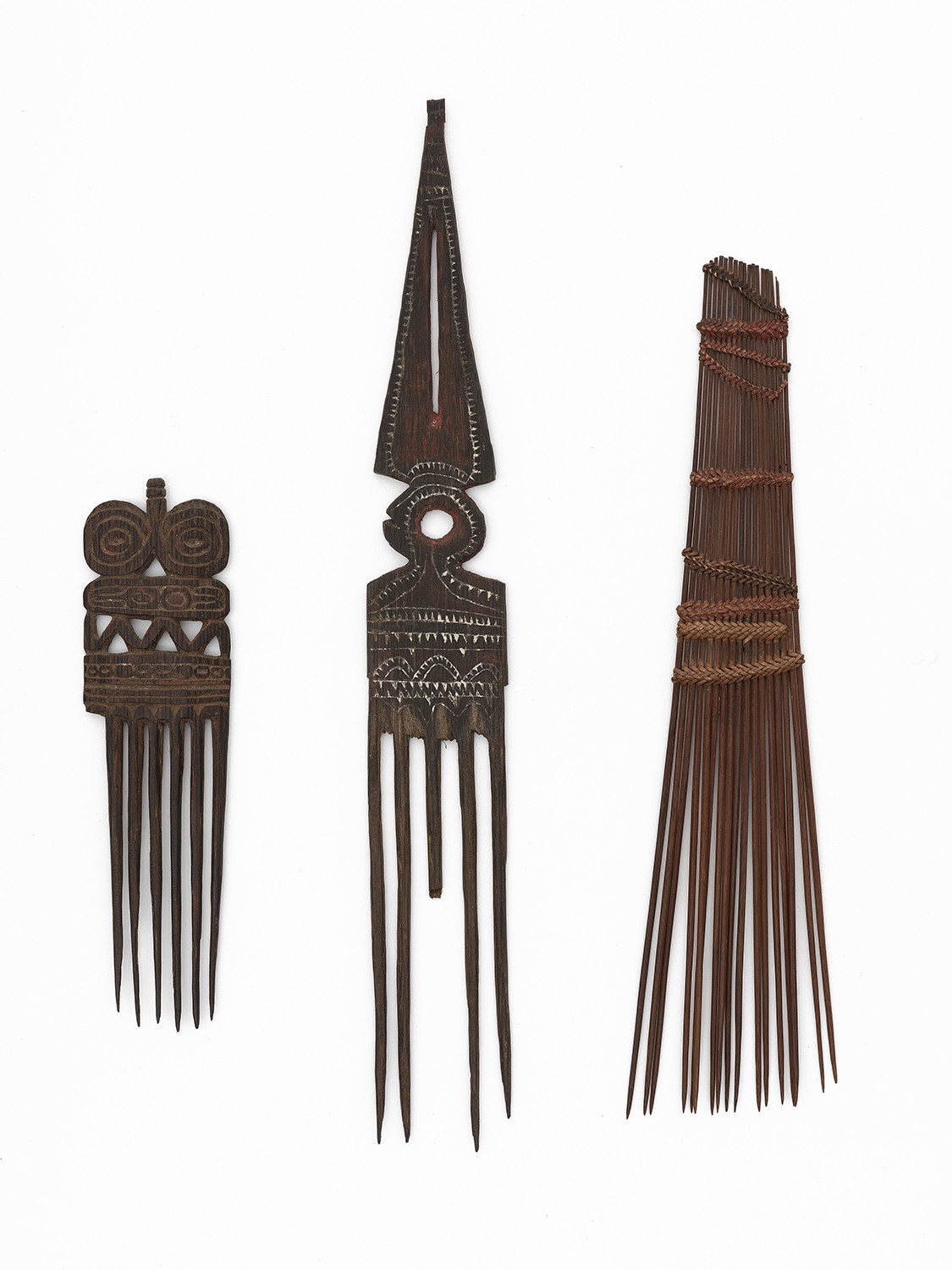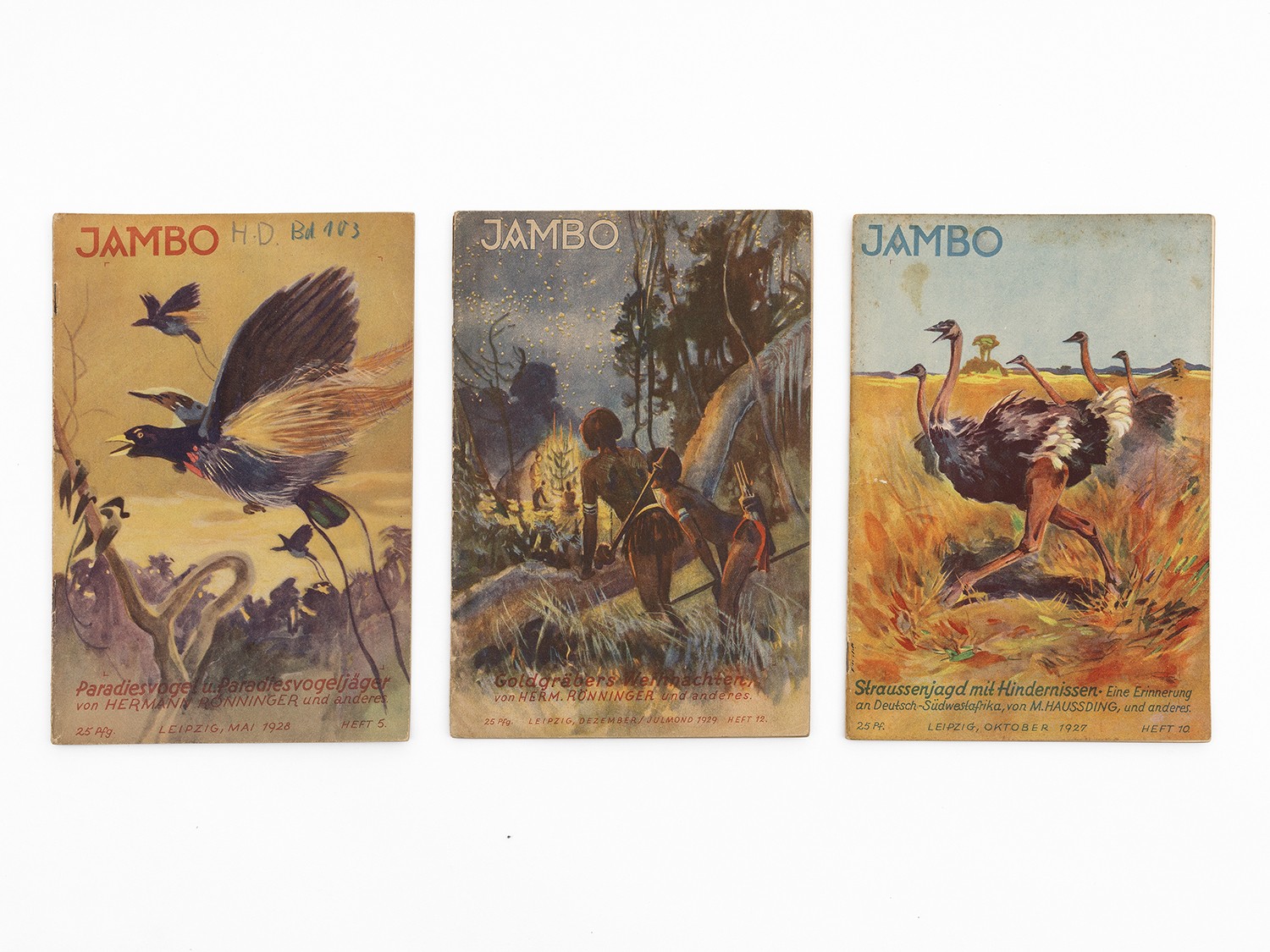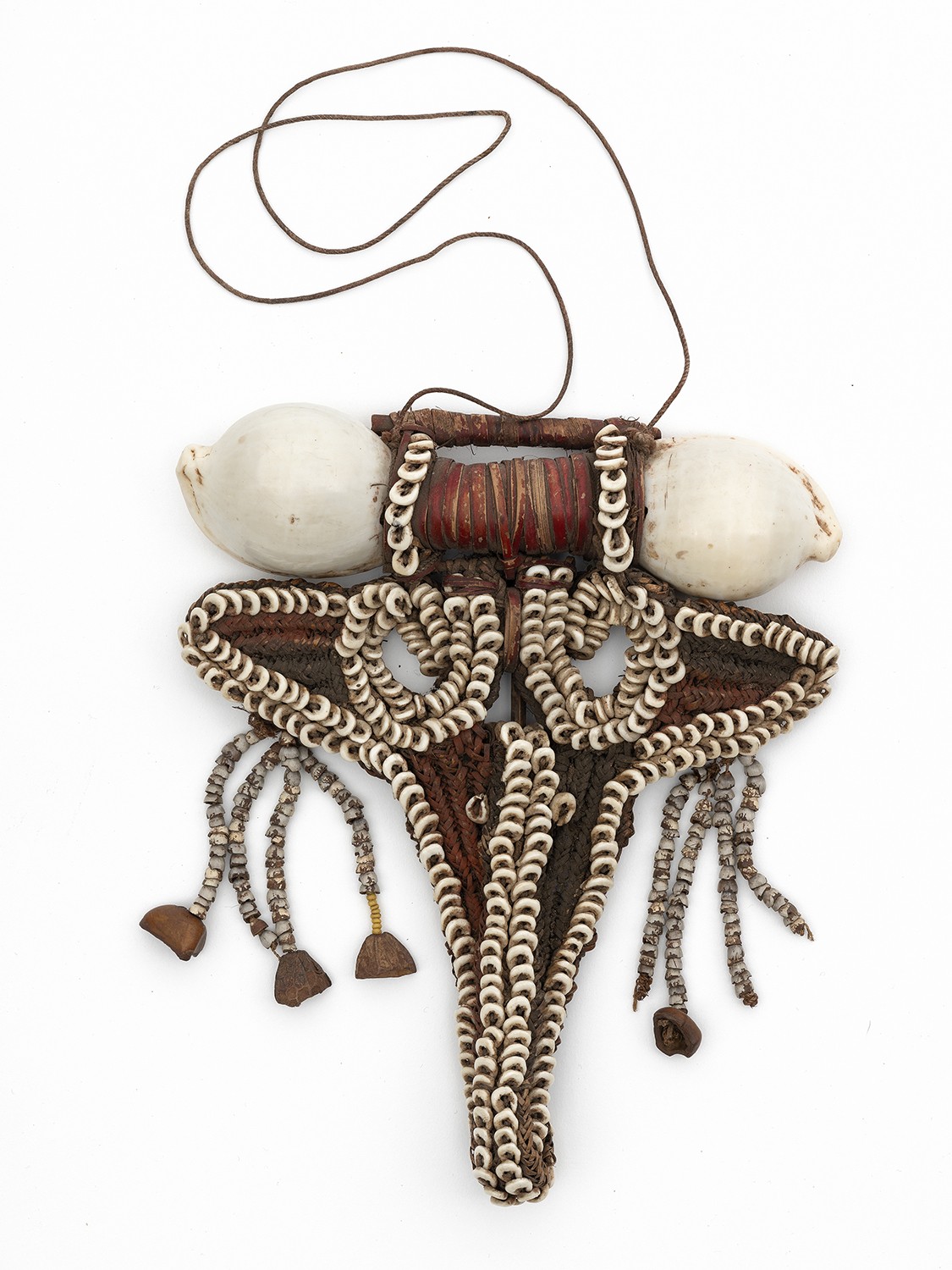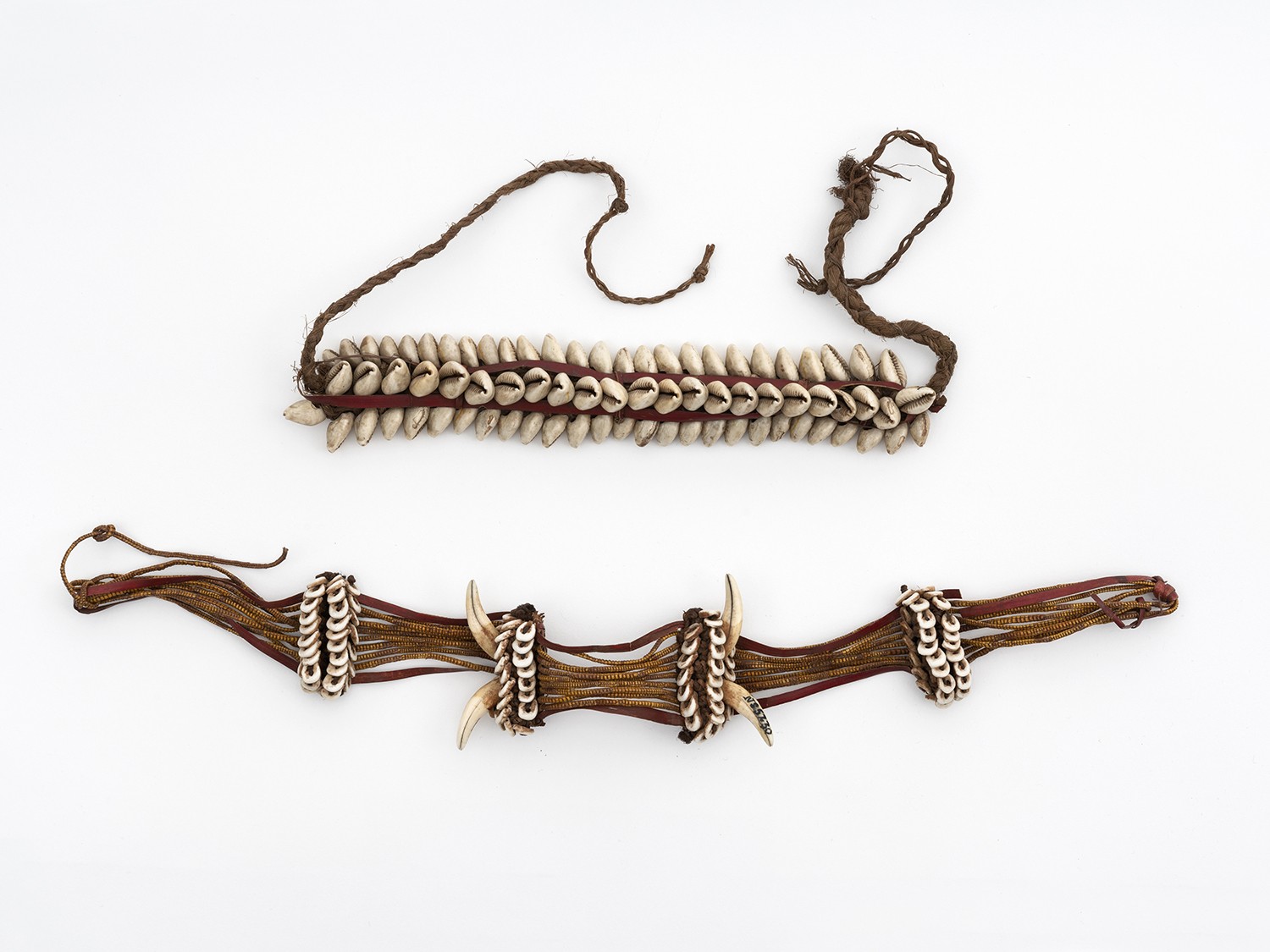THE “HÖLLERER COLLECTION”
16.06.2020
An “Old Shatterhand” of the South Seas? On the track of a colonial-era collection with curator Matthias Claudius Hofmann
The holdings of Frankfurt’s Weltkulturen Museum include a small collection of ethnographic artefacts from New Guinea. They were purchased in 1906, in the early years of the museum, making them some of the oldest objects in the Oceania department. Today around a hundred of these items have survived and are known as the Höllerer Collection.
A Puzzling Collection
The objects come from the north east of what was then a German colony called Kaiser-Wilhelms-Land, now Papua New Guinea. The collection incorporates numerous everyday items such as bowls, net bags, decorative wooden combs and jewellery, clothing made of inner bark, etc, but also diverse weapons such as stone clubs and wooden swords. Then there are a large number of ritual objects: mourning clothing, bullroarers and all kinds of magical objects and paraphernalia. In 1944, Allied aerial bombing of Frankfurt completely destroyed what was then known as the Völkermuseum, along with the holdings remaining within. This included 41 objects from the Höllerer Collection. Moreover, all the documentation about the collection fell victim to the flames. Tragically, not only the purchase records but also background details and the history of the collection went up in smoke.
When I first started looking into these objects in more detail, it seemed utterly impossible that I would be able to shed light on the history of this collection. Where should I even start on my quest to find out more about it’s background, and above all about the collector himself?
In the archiv
The sole surviving documents in the museum’s archive were the inventory index cards and the inventory book, where newly purchased objects were listed and given their own inventory number; in some cases there are also brief details of the purchase. The index cards describe the objects in greater detail, in other words, what they are exactly. In addition to listing the measurements and materials, the function of the object is set out as well as the cultural region where it comes from; frequently this is supplemented by a drawing or glued-on photo. In an analogue era these were vital records for the museums. Generally, the name of the previous owner and the collector were also mentioned here.
The inventory book tells us that it was an architect called Höllerer – after whom the collection is named – who sold the objects to the museum in 1906. Far more significant, however, is a clue as to the identity of the collector: a (sadly unnamed) technician at the Neuendettelsau Mission Society amassed the items between 1904 and 1905 in the Finschhafen area. The key was now to follow this lead and try to identify the collector!
On track of the Collector
Finschhafen is a harbour town in today’s Papua New Guinea, but it was first established as a trading station in 1885, when the north-eastern part of New Guinea became a German imperial colony. It was around this time that the mission society, based in Neuendettelsau near Nuremberg in Bavaria, took up its missionary work with the indigenous population near the town of Finschhafen. The mission’s archive had since been moved to the regional archives of the Bavarian Evangelical Lutheran Church in Nuremberg. It was here that I was able examine not only documents and letters but also information about the staff at the New Guinea mission during the period in question. And as it happened, it could only have been one person: the mission’s engineer Hans Meier. So the identity of our collector was revealed! The archive also contained copious biographical details, certificates, reports and letters, all of which gave me abundant information about him.
Hans Meier
The architect Hans Meier (1876–1955) was employed as the mission’s engineer from 1904 to 1911. His role included building houses, churches, paths and bridges. In his capacity as a surveyor he accompanied the missionaries on numerous expeditions that often lasted for days on end, travelling to the colony’s inaccessible interior as well as to the surrounding islands. In the process, his collecting benefitted from the missionaries’ extensive ethnographic knowledge. Some of the objects in the collection have small labels attached, on which Maier has noted the place, the ethnicity, the indigenous name of the object and often even a short description of the function.
The fact that Meier’s collection contains such a large number of ceremonial objects can probably be explained by the fact that candidates for baptism would apparently destroy or hand over to the missionaries magical or ritual objects such as bullroarers as a sign of their conversion to Christianity. Given that Meier did not leave New Guinea during the period of his employment, he probably asked a trusted aquaintance – Höllerer the architect – to sell the collection for him in Germany. Meier was obviously looking for ways of improving his salary with casual earnings. In addition to the collection in Frankfurt, after his return he sold a similarly large array of items to the Naturhistorische Gesellschaft in Nuremberg.
An “Old Shatterhand” of the South Seas?
Finally, there was another unexpected discovery: the Nuremberg archive contained a note about an address of Meier’s in Passau dating from 1952. When I made enquiries about the residents’ registry in the Passau city archives, I really only wanted to find out the date when the collector died in order to conclude my provenance research.
But it turned out that Meier was also known as a ‘geographical author’ under the pseudonym Hermann Rönninger, and his literary estate – along with photos from New Guinea – was held in the city archives. From the 1920s onwards Hans Meier published a series of adventure stories under this pseudonym, primarily in ‘penny dreadful’ magazines, as well as an ostensibly autobiographical novel, “In der Wildnis Neuguineas” (In the Wilderness of New Guinea). Although Meier claimed to be writing about his experiences in New Guinea, he let his imagination run wild and mixed facts with fantasy. Far from being reports of his actual work in New Guinea, the stories were fictional tales of gold prospectors, hunters and adventurers who advanced through wild jungle landscapes and were forced to prove themselves in conflicts with the “natives”. Later, he even started calling himself Meier-Rönninger, after his literary alter ego, and declared himself to be a colonial pioneer, gold prospector, big game hunter and plantation owner who had tragically lost everything he owned at the outbreak of World War I. In actual fact, by 1911 – long before the war started – he had been fired by the mission after a quarrel and then compelled by the missionaries to return to Germany. You could be forgiven for thinking you were on the tail of a ‘Karl May of the South Seas’, perfecting his very own “Old Shatterhand” legend. Karl May was the famous German writer best known for his adventure stories set in the American “wild west”, and Old Shatterhand was one of his main protagonists and May’s alter ego. Looking through the assorted autobiographical documents, letters and newspaper interviews connected with Meier, along with his adventure stories – which he claimed were “factual reports” –it is possible to trace the gradual transformation of Hans Meier into his own fictional alter ego Hermann Rönninger. This was an author who really turned his biography into an adventure novel.
This collection gives us insights into both early twentieth-century New Guinea and the history of missionary work during the German colonial era. But above and beyond that: the collector himself, Hans Meier, is a fascinating, if somewhat shifty, colonial player of the era.
Matthias Claudius Hofmann, curator Oceania
 Decoration combs. Collector: Hans Meier 1904/1905, acquisition from Hans Höllerer 1906, Collection Weltkulturen Museum. Photo: Wolfgang Günzel
Decoration combs. Collector: Hans Meier 1904/1905, acquisition from Hans Höllerer 1906, Collection Weltkulturen Museum. Photo: Wolfgang Günzel Title covers from the pulp novel series “Jambo” with short stories by Hermann (Hans Meier) Rönninger, 1927-1929, Collection Weltkulturen Museum. Photo: Wolfgang Günzel
Title covers from the pulp novel series “Jambo” with short stories by Hermann (Hans Meier) Rönninger, 1927-1929, Collection Weltkulturen Museum. Photo: Wolfgang Günzel Breast ornament; plant fibres, sea snail shells (nassa, ovulids), woven red leaves, Job’s tears plant seeds; acquisition: Hans Höllerer 1906; collection: Weltkulturen Museum. Photo: Wolfgang Günzel
Breast ornament; plant fibres, sea snail shells (nassa, ovulids), woven red leaves, Job’s tears plant seeds; acquisition: Hans Höllerer 1906; collection: Weltkulturen Museum. Photo: Wolfgang Günzel Necklaces. Collector: Hans Meier 1904/1905, acquisition from Hans Höllerer 1906, Collection Weltkulturen Museum. Photo: Wolfgang Günzel
Necklaces. Collector: Hans Meier 1904/1905, acquisition from Hans Höllerer 1906, Collection Weltkulturen Museum. Photo: Wolfgang Günzel
